English version at the bottom of this page
Radfahren in NYC ist nicht nur etwas für Wagemutige. Mehr und mehr integriert sich das Rad in das Verkehrsgeschehen im „Big Apple“ und dabei war das Verleihradsystem Citibike nicht ganz unschuldig. Und ein Umdenken in Sachen Infrastruktur, das vor ungefähr 10 Jahren begann. Seither entstehen nicht nur immer mehr Radrouten, sondern es gibt mit Parks und Strecken z.B. an den Flussläufen auch echte Rückzugsräume für Radfahrer. Die Zuschrift einer Leserin erinnerte mich daran, dass ich dazu ja ein bisschen was schreiben wollte. Also los geht´s: Teil 1 der kleinen Serie beschäftigt sich mit den Basics.
Grundsätzliches
New York City ist noch lange keine Fahrradstadt, wie man es nach Europäischem Maßstab erwarten könnte. In allen Stadtteilen dominiert das Auto und der öffentliche Verkehr ist in die Jahre gekommen und damit ist auch die Fahrradmitnahme nicht immer ein Vergnügen. Dies möchte ich vorweg schicken, um deutlich zu machen: Radfahren in NYC ist nicht undenkbar, zur Zeit muss man aber an der einen oder anderen Stelle echt noch Abstriche machen. Daran ändern auch die umfangreichen Bemühungen allerorten nichts.
Tipp: Alleine oder mit Kindern – gewöhnt Euch am besten schon zu Hause an das Fahren auf der Straße. Vor Ort bietet es sich an manche Strecken vorsichtig und ggf. nach und nach zu erkunden.
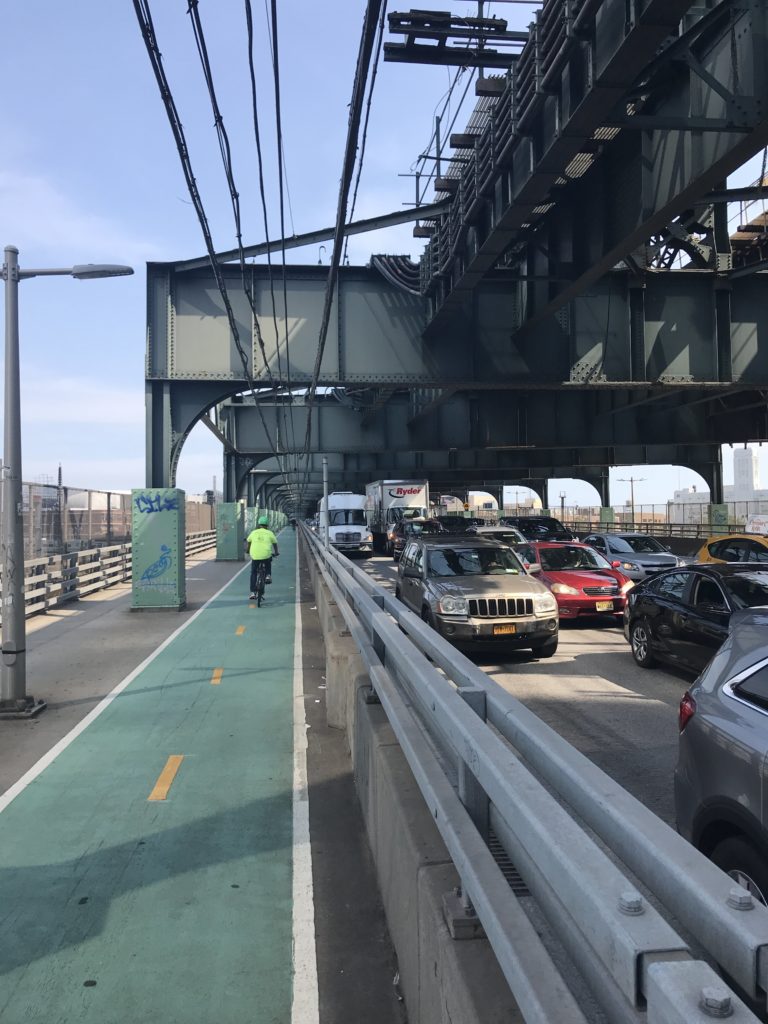
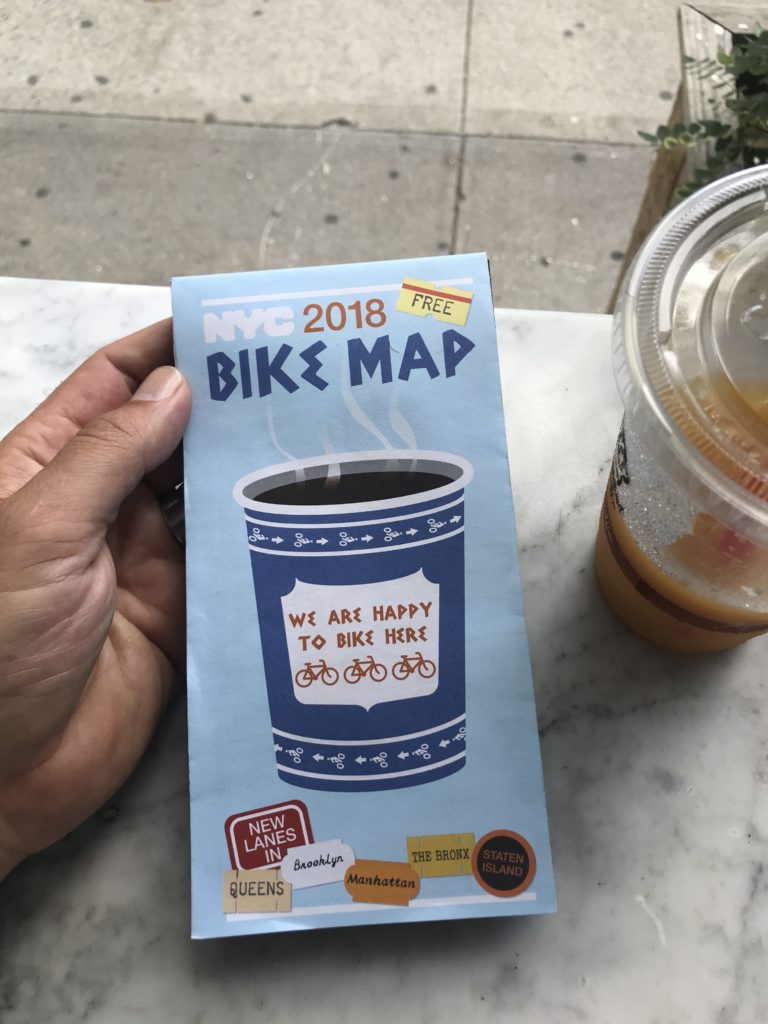
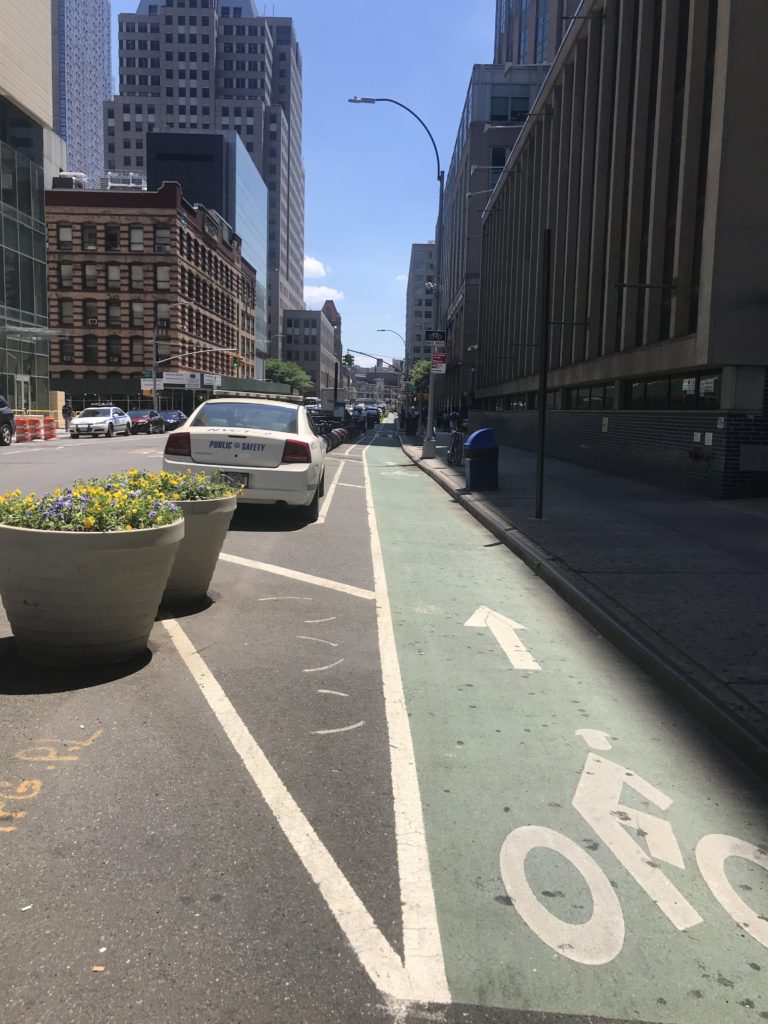
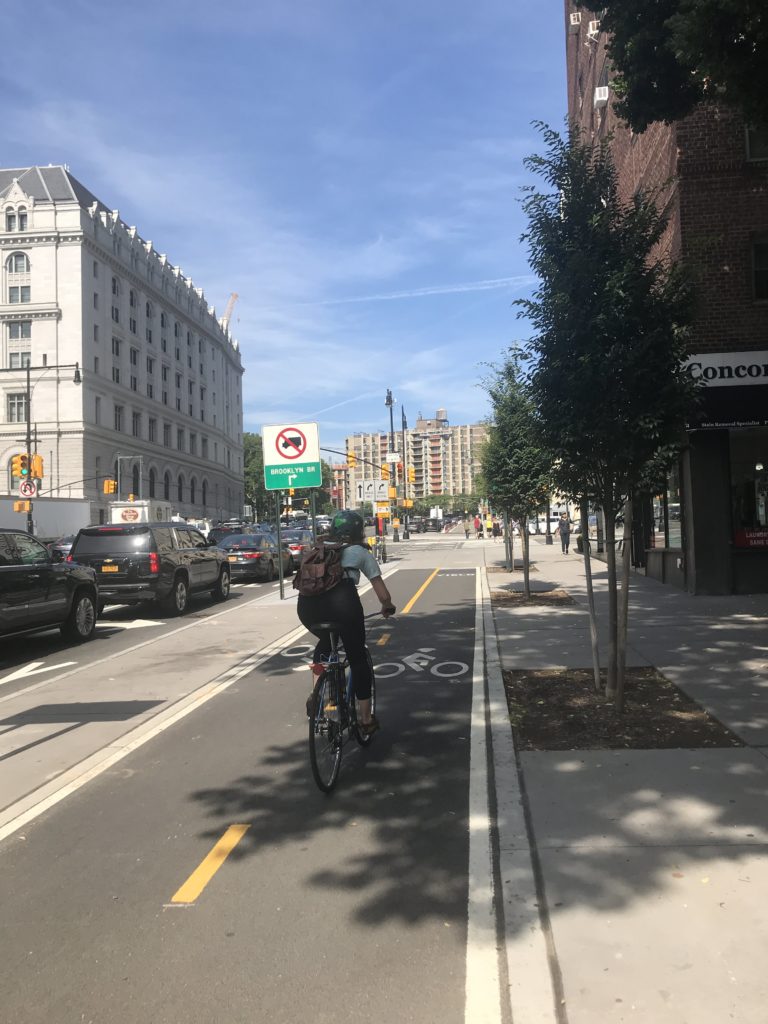
Fahrradrouten und -karte
In New York werden verschiedene Kategorien von Radrouten unterschieden. Solche, die völlig separat vom Autoverkehr geführt werden – so genannte „Protected Bikelanes“, dann Fahrradstreifen (Conventional Bicycle Lane) auf der Fahrbahn, als drittes „Shared Lanes“ – hier fährt man mit den Autos auf der Straße. Und zuletzt „Signed Routes“ – diese verfügen über keinerlei Markierung auf der Straße. Einzig ein Schild am Straßenrand weist darauf hin, dass hier auch Rad gefahren wird. Diese Unterscheidung ist insofern hilfreich, als das man seine Touren anhand der kostenlos verfügbaren Fahrradkarte von NYC gut planen kann. Vorzugsweise bewegt man sich dabei auf den „Protected Bikelanes“. Die haben aber noch Lücken und sind auch sonst teils gewöhnungsbedürftig.
Protected Bikelanes
Die Idee hinter den separaten Radwegen ist einleuchtend und führt in NYC zu guten Ergebnissen: Radfahrer fahren auf eigenen, baulich getrennten Radwegen. Nicht solche, wie man sie z. B. in Deutschland kennt – irgendwie an die Seite geklatscht, um Radfahrer samt Fußgänger an den Rand zu drängen. Nein, hier wird ein ausreichend breiter Radweg auf der Straße oder ganz separat geführt und mit einem Hochbord oder Pollern geschützt.
Das funktioniert in New York vor allen Dingen an den Flussufern hervorrragend. Am Eastriver, z. B. in Brooklyn, aber auch am Hudson in Manhattan, sind lange und sehr entspannt zu fahrenden Abschnitte entstanden. Hier können auch Familien – sogar mit kleineren Kindern, lange, abwechslungsreiche Touren unternehmen.
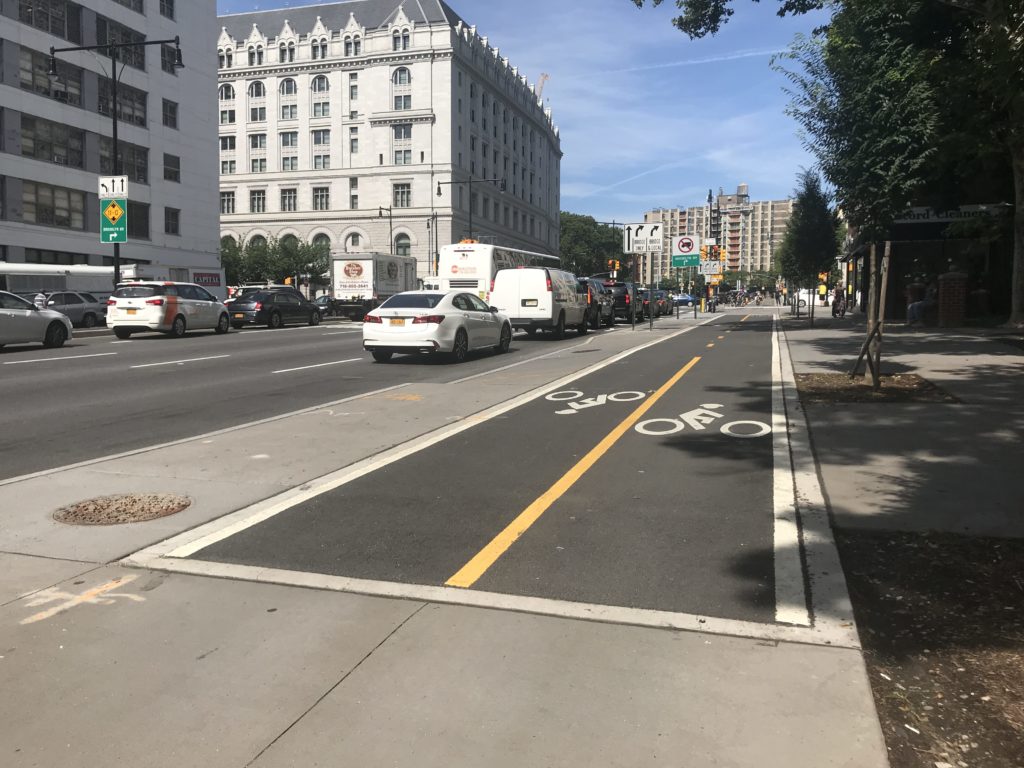
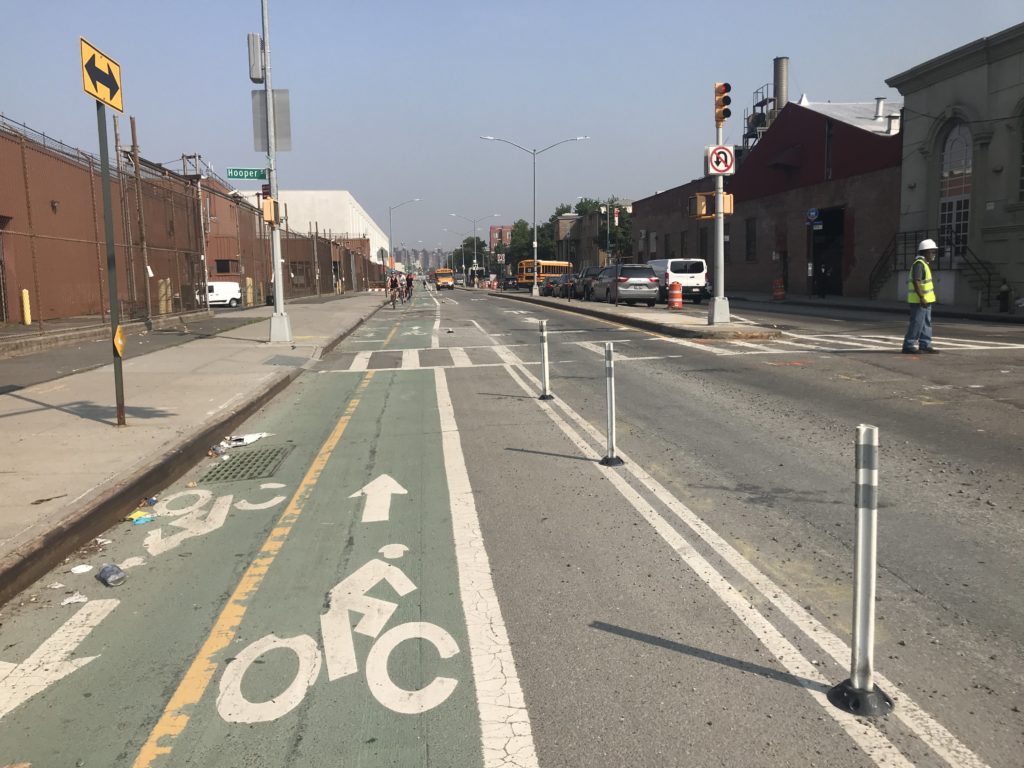
Nicht alles Gold was glänzt
Aber Vorsicht: Bikelane ist nicht gleich Bikelane. Im dichten Innenstadtbereich sind die Radrouten teils bemerkenswert geführt – häufig auf der linken Seite. Das bietet zwar guten Schutz, führt aber auch zu Gewöhnungsbedarf. Vor allen Dingen im Zusammenspiel mit Linksabbiegern der PKW-Spur. Und: nicht jede ausgewiesene Bikelane ist auch schon fertig. Mancherorts ist die grausige Straßenoberfläche nur mit zwei grünen Fahrspuren eingefärbt. Häufig gibt es dann gerade an diesen Stellen auch noch Dauerbaustellen. Um die Fahrradroute fertig zu stellen, sind mancherorts umfangreiche Arbeiten notwendig – die sich teils über Jahre ziehen. Das Ergebnis: unübersichtliche und mitunter gefährliche Streckenabschnitte.
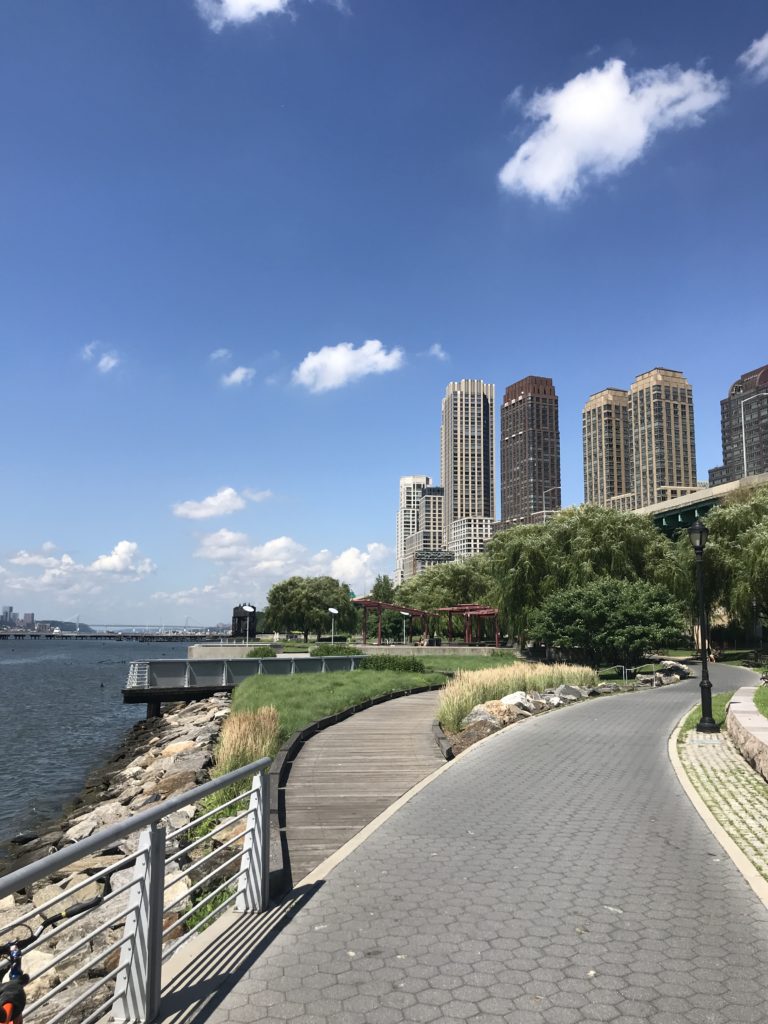
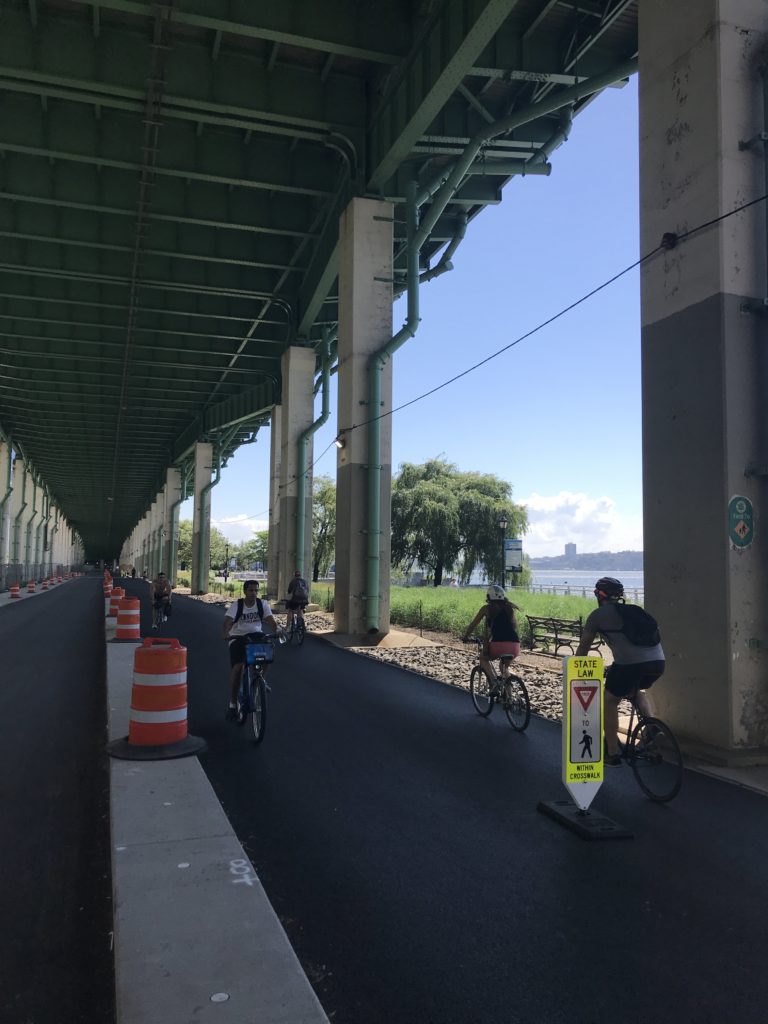
Andere Radwege
Alle anderen Kategorien – „Conventional Bicycle-„, „Shared-Lanes“ und „Signed Routes“ haben eines gemeinsam: sie sind zarte Hinweise darauf, dass hier eben auch Radfahrer unterwegs sind . Die Markierungen auf der Straße, sind oft nicht die Farbe wert, mit der sie markiert wurden. Ständig parkt jemand in zweiter Reihe (oder steht dort dauerhaft), fährt etwaige Lücken zu oder kümmert sich eben gar nicht um die Belange der Radler. Dann fühlt man sich manchmal, wie einer dieser Messenger der durch die Automassen von Manhattan zirkelt. Die gute Nachricht: nicht überall, vor allen Dingen nicht außerhalb Manhattans ist immer und überall so viel Verkehr. In den Wohngegenden, z. B. in Brooklyn kann man ganz entspannt Sight-Seeing-Touren per Rad unternehmen.
English version:
Cycling in NYC is not just for the daring. More and more, the bicycle is integrated into the traffic in the „Big Apple“ and the rental bike Citibike was not entirely innocent. And a rethinking of infrastructure that started about 10 years ago. Since then, not only are more and more cycle routes emerging, but there are also parks and routes, e.g. on the rivers also real retreats for cyclists. The letter from a reader reminded me that I wanted to write a bit about it. So let’s start: Part 1 of the small series deals with the basics.
The Basics
New York City is far from being a cycling city, as one would expect on a European scale. In all parts of the city the car is dominating and the public transport is getting old and thus the bicycle is not always a pleasure. I would like to send this in advance, to make it clear: Cycling in NYC is not unthinkable, but at the moment you have to cut corners at one point or another. This does not change the extensive efforts everywhere.
Tip: Alone or with children — get used to driving on the street at home. Locally, it offers to explore routes carefully and if possible gradually. On the weekend, there is less traffic, which is good for practicing.
Bikeroutes and -map
In New York different categories of cycle routes are distinguished. Those that are completely separate from car traffic – so-called „Protected Bikelanes“, then bicycle lanes (Conventional Bicycle Lane) on the road, as the third „shared lanes“ – here you drive with the cars on the road. And finally „Signed Routes“ – these have no markings on the road. Only a sign on the side of the road indicates that here also bike is driven. This distinction is helpful in that you can plan your tours well with the free available NYC cycling map. Preferably, you move on the „Protected Bikelanes“. But they still have gaps and partly you got to get used to them.
.
Protected Bikelanes
The idea behind the separate bike lanes is obvious and leads to good results in NYC: cyclists ride on their own, physically separate bike paths.Not such, as they f.e. are known in Germany – somehow clapped to the side to urge cyclists and pedestrians to the edge. No, here is a sufficiently wide bike path on the road or run separately and protected with a highboard or bollards.
This works great in New York, especially on the riverbanks. At the Eastriver, for example, in Brooklyn, but also on the Hudson in Manhattan, long and very relaxed to moving sections have emerged. Here families can do long, varied tours, even with smaller children.
Not all gold what shines
But beware: Bikelane is not the same as Bikelane. In the dense inner city area, the bike routes are sometimes remarkably guided – often on the left side. Although this provides good protection, this also leads to habituation needs. Above all, in interaction with left-handers of the car lane. And: not every designated bikelane is already finished. In some places, the grisly road surface is colored only with two green lanes. Often there are then even at these points under permanent construction. In order to complete the cycle route, extensive work is necessary in some places – sometimes over years. The result: confusing and sometimes dangerous sections of the route.
Other cycle paths
All other categories – „Conventional Bicycle“, „Shared Lanes“ and „Signed Routes“ have one thing in common: they are tender indications that cyclists are also on the road here. The markings on the road are often not worth the color with which they were marked. Constantly someone parked in the second row (or stands there permanently), closes any gaps or nobody cares about the concerns of the cyclists at all. Then you sometimes feel like one of those messengers is circling through the Manhattan car centered streets. The good news: not everywhere, especially outside Manhattan, there is always and everywhere so much traffic. In the residential areas, for example, in Brooklyn, you can take relaxed sight-seeing tours by bike.
For the second part of the series I deal with the most important thing: how do I get a bike?




